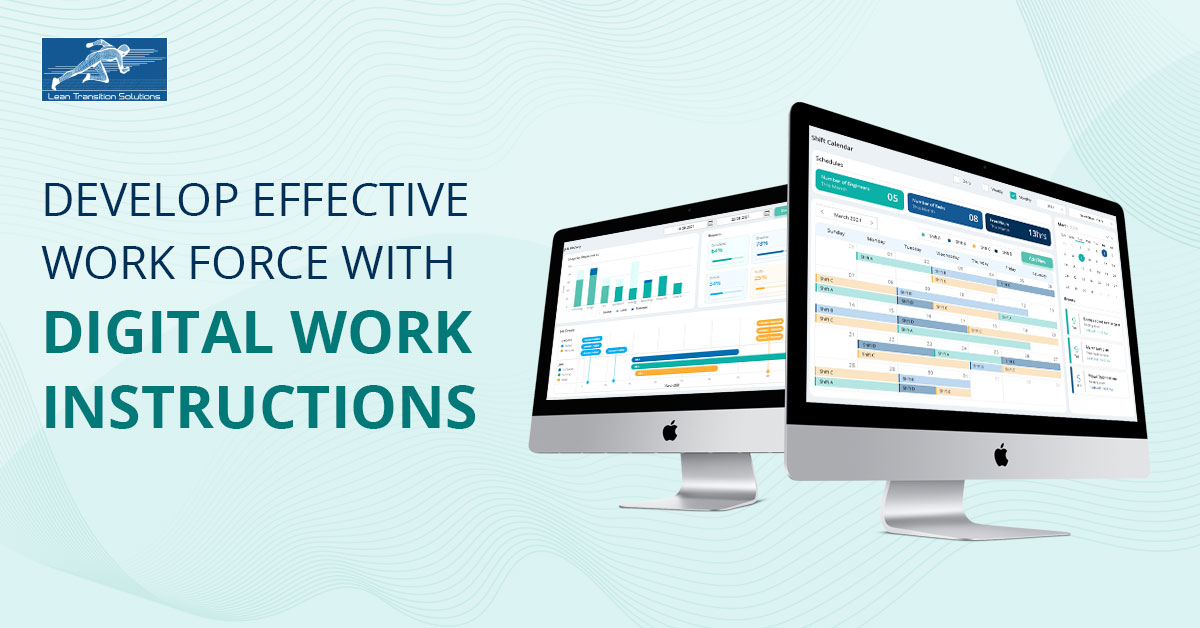Why should organisations switch to Digital Work Instructions?
September 12, 2022
Striving for a manufacturing operations transformation? Get well along with your continuous improvement journey. You will see digitalisation taking over your current process at some point in the journey. Digital systems will start to supersede your paper systems. One striking example of digitalisation in your continuous improvement journey is the digitalisation of your standard work instructions. Give them a second thought if paper cards are still lingering on your shop floors. Plan your digital strategies in the right way. Boost your operational efficiency and productiveness with Digital Work instructions.
Digital Work Instructions for the Future Factories
Industry 4.0 has forced industries to raise their standards. The shop floor has become more transparent. The complex digital services started becoming controlled from anywhere. To keep up the pace of competition, reinforce the measures and enforce a continuous improvement culture, future factories must ensure that communication between the digital device and human counterparts is smooth.
Along with the evolution of Industry 4.0, standard work instructions have also evolved. Digitalising work instruction has become an indispensable factor in developing a smart factory. With the ability to standardise the operations and collect essential information, digital standard work instructions aid in achieving smart manufacturing goals. Redefining work instructions for this digital era will let companies maintain a competitive edge and approach the future with confidence.
Why should your organisation switch to digital work instructions?
● Boost your manufacturing productivity: Being more interactive and user-friendly lets the operator visualise how to perform a task. Here the time lost in deciphering the paperwork instructions is gained. A better understanding of the process can contribute to building a more efficient production line and improve productivity.
● Faster and more efficient training: Using the mobile and interactive content of the digital work instructions encourages the employees to learn the new operating procedures. It also provides on-the-job training by showing how to perform new tasks.
● Institutionalise tribal knowledge: Digital work instruction can capture the tribal knowledge, which can get lost when the experienced operators retire. Passing this knowledge to the next generation is not a tedious task anymore.
● Reduce change over time: Unnecessary tasks causing the change over time can be identified through the electronic work instructions, once the functions are free of errors, defects and slowness, the change over time is reduced, and the process becomes efficient.
● Continuous improvement approach: By digitising the work instructions, the tasks are simplified and allow the operators to improve efficiency, identify the relevance of each step and suggest improvements. Effective utilisation of digital work instructions becomes a part of the continuous improvement approach.
Digital work instructions have a transformative effect on the production industry. It can produce more motivated and inspired operators by helping to improve the quality, reducing errors and boosting retention.
How to migrate from your paper instructions into digital work instructions?
Find the steps to migrate to the digital work instructions from your paper instructions.
Step1: Find the right platform
Selecting the right platform for the instructions is the first step. It should be one easy to maintain, manage and easy to find when the workers need it. Place it near where the work is done and should be accessible on demand.
Step 2: List the current work instructions
Have an account of:
Who owns them now?
Where are they placed?
What format are they in?
Are there multiple copies available?
When were they last updated?
Are they complete?
Are they used in daily operations?
Have a complete assessment of how they are currently used.
Step 3: Set the priorities
Take one step each time. Start prioritising. List the processes with the most pain points and assemble all the existing work instructions. Evaluate them and put the urgent ones first, and execute the plans.
Step 4: Involve the right people.
Get the right people on the project, in addition to the usual workers, involve some senior operators and a couple of newbies.
Step 5: Illustrate the Goals and get the feedback
Explain your goals in the kick-off meeting itself. What is the objective, and how is it executed? How can transitioning to digital instruction be accomplished, and when will it begin? Get feedback on the work instructions from the team members. Teach them how the digital work instructions are going to work.
Step 6: Create the Digital Work Instructions
Finalise the best outcomes and create suitable visual aids, steps and other supporting content. Load it into our Digital T Card software systems. Make sure that everyone working in the area is fully aware of the new digital strategy and that they have complete access to it.
Step 7: Familiarise the system
Though a complicated process, try to familiarise it with the team and ensure regular follow-up on the instructions. Review it again, ensure you are on the right track or check if the system needs any modifications.
Step 8: Publish the digital standard work instructions
Being a part of the continuous improvement process reinforces adherence to standard work instructions. The floor supervisors should be diligent in enforcing compliance with the standards. Maintaining the history of the work instruction and tracking the changes can help get an overview of how it works for the system.
Step 9: Follow the same process for the entire industry.
Repeat the process sector by sector with one or two processes simultaneously and establish the methodology. Over time, try to make it a way of life.
With the industries transitioning to future factories, the traditional "one fits all" approach and on-job support cannot pull out the productivity of the workers to the max. Digital work instructions are not a simple transformation from paper to digital systems. By digitalising your workflows, you get to digitise your complex business processes themselves. Don't delegate the process of digital transformation. Go digital, grow with it and own it.
